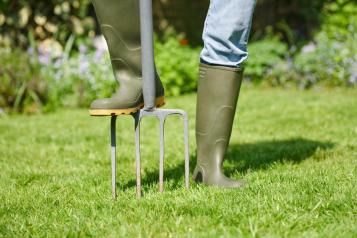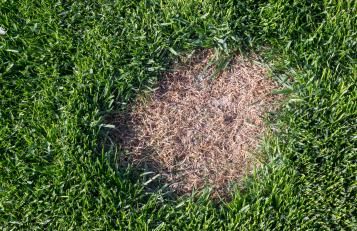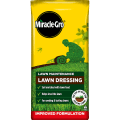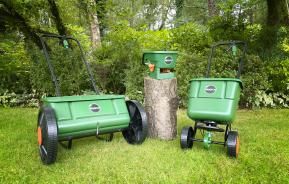Clear away fallen leaves
Start preparing your lawn for winter by tidying up! Let your grass make the most of low winter light levels and short days by raking it regularly in autumn to clear fallen leaves and other debris. Move toys and summer garden furniture off the lawn and store them somewhere dry ready for next spring.

Mow your lawn before winter
As the grass starts to grow more slowly, cut your lawn less often and on a high mower setting. Traditionally, the last date for mowing is usually October or early November, but don’t put your mower away completely! In cold winters the grass will stop growing altogether and you won’t need to mow, but in mild weather you may need to give it an occasional trim just to keep it tidy.
Look after your lawn in winter with these three key winter lawn care tips:
- Never mow frosty or frozen lawns, as this will damage the grass blades.
- Don’t mow wet grass – it tends to clump together, giving an uneven cut and potentially damaging your lawnmower.
- Avoid walking on wet lawns, as this will compact the soil. Stay off frosty lawns too, as walking on the frozen grass will damage it.
Scarify to remove thatch
The next step in pre-winter lawn care is to scarify the lawn. This gets rid of thatch, which is a layer of dead grass and other plant debris that builds up around grass roots over time. Removing thatch improves air circulation, reducing the risk of fungal diseases, and also makes it easier for water to reach the roots of the grass.
You can scarify small lawns by hand using a spring tine rake, raking firmly over the grass. However, this can be quite hard work, so for large areas you may find it easier to use a mechanical scarifier.
Aerate the soil
Our lawns get a lot of foot traffic over summer, and this results in compacted soil. Aerating the lawn in autumn is an important part of winter lawn preparation, breaking up the compacted soil, improving drainage and getting oxygen back into the soil so that roots can grow strong.
The simplest way to aerate your lawn is with a garden fork. Press the tines of the fork as far into the soil as possible – at least 3-4in deep. Lean gently on the handle of the fork so that the soil around the tines lifts very slightly, then remove the fork. Move a short distance away and repeat. For heavy clay soils, use a hollow tine aerator rather than a garden fork. This removes small plugs of soil from the lawn, leaving holes which can then be filled with top dressing.
If your garden is too large to do all in one go, you can simply aerate a section each year, or use a mechanical aerator.













